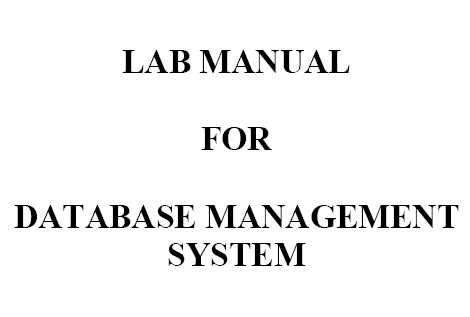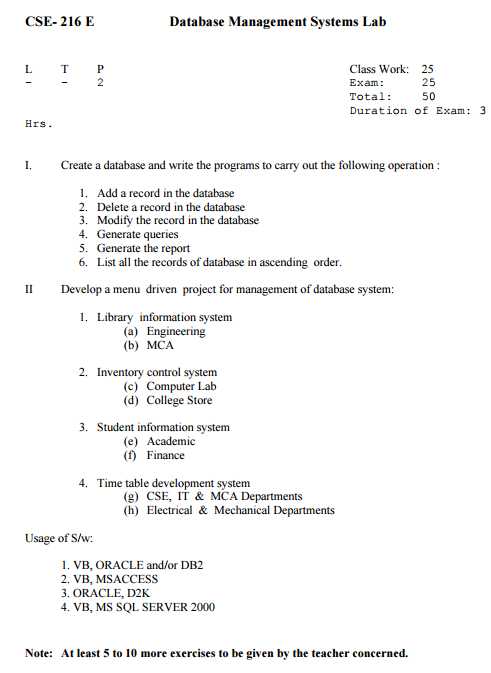| 16th November 2015 01:53 PM | ||
| sumit | Re: Mumbai University DBMS Lab Manual As you want to get the University of Mumbai DBMS Lab Manual so here is the information of the same for you: Some content of the file has been given here: Unit – I Introduction to Databases and Transactions: What is database system, purpose of database system, view of data, relational databases, database architecture, transaction management Unit- II Data Models: The importance of data models, Basic building blocks, Business rules, The evolution of data models, Degrees of data abstraction. Unit-III Database Design, ER-Diagram and Unified Modeling Language: Database design and ER Model  verview, ER-Model, Constraints, ER-Diagrams, ERD Issues, weak entity sets, Codd’s rules, Relational Schemas, Introduction to UML verview, ER-Model, Constraints, ER-Diagrams, ERD Issues, weak entity sets, Codd’s rules, Relational Schemas, Introduction to UMLRelational database model: Logical view of data, keys, integrity rules. Relational Database design: Features of good relational database design, atomic domain and Normalization (1NF, 2NF, 3NF, BCNF). Unit- IV Relational Algebra and Calculus: Relational algebra: Introduction, Selection and projection, set operations, renaming, Joins, Division, syntax, semantics. Operators, grouping and ungrouping, relational comparison. Calculus: Tuple relational calculus, Domain relational Calculus, calculus vs algebra, computational capabilities. Unit- V Constraints, Views and SQL: What is constraints, types of constrains, Integrity constraints, Views: Introduction to views, data independence, security, updates on views, comparison between tables and views SQL: Data definition, aggregate function, Null Values, nested sub queries, Joined relations. Unit-VI Transaction management and Concurrency control: Transaction management: ACID properties, serializability and concurrency control, Lock based concurrency control (2PL, Deadlocks),Time stamping methods, optimistic methods, database recovery management. Books: A Silberschatz, H Korth, S Sudarshan, “Database System and Concepts”, fifth Edition McGraw-Hill, Rob, Coronel, “Database Systems”, Seventh Edition, Cengage Learning. Practicals: 1) Design a Database and create required tables. For e.g. Bank, College Database 2) Apply the constraints like Primary Key , Foreign key, NOT NULL to the tables. 3) Write a sql statement for implementing ALTER,UPDATE and DELETE 4) Write the queries to implement the joins 5) Write the query for implementing the following functions: MAX(),MIN(),AVG(),COUNT() 6) Write the query to implement the concept of Intergrity constrains 7) Write the query to create the views 8) Perform the queries for triggers 9) Perform the following operation for demonstrating the insertion , updation and deletion using the referential integrity constraints 10) Write the query for creating the users and their role. INTRODUCTION TO DATABASE MANAGEMENT SYSTEM: Unit Structure 1.0 Objectives 1.1 Introduction 1.2 What is Database Management System 1.3 History of Database System 1.4 Purpose of Database System 1.5 Advantages and Disadvantages of Database System 1.6 Summary 1.7 Model Questions 1.1 INTRODUCTION In today’s world as the information technology has changed rapidly, many computing applications deal with large amounts of information regularly. As the end user applications has changed significantly in last few decades, there is a challenge to store the large amount of information, retrieve and manage this information in timely manner. This can be achieving today by making use of services of Database Management System (DBMS). Today DBMS not only used to insert, update and delete the data stored in database. The job of DBMS system is to collect the data, give a systematic representation to it and also provides ways for the data to be modified or extracted by users or other programs. As the technology has grown rapidly in past four decades, today DBMS has gain its own importance because the data has brought online in the hands of end user through different computer networking. For more detailed information I am uploading 2 PDF file which are free to download: University of Mumbai DBMS Lab Manual   Contact Details: University of Mumbai CST Road, Kalina, Santacruz East Mumbai, Maharashtra 400098 India | |
| 16th November 2015 01:43 PM | ||
| Unregistered | Mumbai University DBMS Lab Manual Will you please share with me the University of Mumbai DBMS Lab Manual as it is very urgent for me? | |